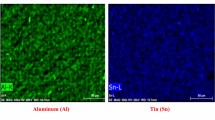Abstract
In the current study, the machining performance evaluation of electric discharge-machined Cobalt Chromium (Co–Cr) and β-type titanium (Ti) alloys is reported. The research investigation was carried out using Taguchi’s L9 orthogonal array with the electrode, current, pulse-on time, and pulse-off time as the input variables. For determining the importance of machining performance parameters on the machined surface of both biomedical alloys, material removal rate was determined. The material removal rate calculations’ findings showed that the titanium alloy substrate had 1.5 times higher MRR than the Co–Cr alloy substrate. The ideal parametric configuration for machining is a 16 A peak current at a 150 ms pulse on time and a 60 ms pulse off time with a tungsten-copper (W–Cu) electrode. An examination of the surface’s morphology showed that low metal removal rate machining produces surfaces with higher integrity when compared to high metal removal rate machining.
Access this chapter
Tax calculation will be finalised at checkout
Purchases are for personal use only
Similar content being viewed by others
References
Kumar S, Singh R, Singh TP, Sethi BL (2009) Surface modification by electrical discharge machining: a review. J Mater Process Technol 209:3675–3687. https://doi.org/10.1016/J.JMATPROTEC.2008.09.032
Ho KH, Newman ST (2003) State of the art electrical discharge machining (EDM). Int J Mach Tools Manuf 43:1287–1300. https://doi.org/10.1016/S0890-6955(03)00162-7
Singh G, Sidhu SS, Bains PS, Bhui AS (2019) Surface evaluation of ED machined 316L stainless steel in TiO2 nano-powder mixed dielectric medium. Mater Today Proc 18:1297–1303. https://doi.org/10.1016/J.MATPR.2019.06.592
Mahajan A, Sidhu SS, Ablyaz T (2019) EDM Surface Treatment: An Enhanced Biocompatible Interface, Material Horizons From Nature to Nanomaterial. pp 33–40. https://doi.org/10.1007/978-981-13-9977-0_3/COVER
Bhui AS, Singh G, Sidhu SS, Bains PS (2018) EXPERIMENTAL INVESTIGATION OF OPTIMAL ED MACHINING PARAMETERS FOR Ti-6Al-4V BIOMATERIAL. Facta Univ Ser Mech Eng 16:337–345. https://doi.org/10.22190/FUME180824033B
Srivastava V, Pandey PM (2013) Study of ultrasonic assisted cryogenically cooled EDM process using sintered (Cu–TiC) tooltip. J Manuf Process 15:158–166. https://doi.org/10.1016/J.JMAPRO.2012.12.002
Guu YH, Hocheng H, Chou CY, Deng CS (2003) Effect of electrical discharge machining on surface characteristics and machining damage of AISI D2 tool steel. Mater Sci Eng A 358:37–43. https://doi.org/10.1016/S0921-5093(03)00272-7
Das MK, Kumar K, Barman TK, Sahoo P (2014) Application of artificial bee colony algorithm for optimization of mrr and surface roughness in EDM of EN31 tool steel. Procedia Mater Sci 6:741–751. https://doi.org/10.1016/J.MSPRO.2014.07.090
Sharif S, Safiei W, Mansor AF, Isa MHM, Saad RM (2015) Experimental study of electrical discharge machine (die sinking) on stainless steel 316L using design of experiment. Procedia Manuf 2:147–152. https://doi.org/10.1016/J.PROMFG.2015.07.026
Mahajan A, Devgan S, Kalyanasundaram D (2022) Surface alteration of Cobalt-Chromium and duplex stainless steel alloys for biomedical applications: a concise review. Mater Manuf Process. https://doi.org/10.1080/10426914.2022.2105873
Mahajan A, Singh G, Devgan S, Sidhu SS (2020) EDM performance characteristics and electrochemical corrosion analysis of Co-Cr alloy and duplex stainless steel: a comparative study. Proc Inst Mech Eng E: J Process Mech Eng 235:812–823. https://doi.org/10.1177/0954408920976739
Devgan S, Mahajan A, Singh G, Singh G, Sidhu SS (2022) Surface integrity of powder mixed electrical discharge treated substrate at high discharge energies. Lecture notes mechanical engineering. pp 207–217. https://doi.org/10.1007/978-981-16-2278-6_18/COVER
Chen YF, Chow HM, Lin YC, Lin CT (2008) Surface modification using semi-sintered electrodes on electrical discharge machining. Int J Adv Manuf Technol 36:490–500. https://doi.org/10.1007/S00170-006-0859-X
Singh G, Mahajan A, Devgan S, Sidhu SS (2022) Comparison of copper and tungsten electrodes for the electric discharge machined SUS-316L. Lecture notes mechanical engineering. pp 197–206. https://doi.org/10.1007/978-981-16-2278-6_17/COVER
Li G, Wang L, Pan W, Yang F, Jiang W, Wu X, Kong X, Dai K, Hao Y (2016) In vitro and in vivo study of additive manufactured porous Ti6Al4V scaffolds for repairing bone defects. Sci Rep 6(1):1–11. https://doi.org/10.1038/srep34072
Gittens RA, McLachlan T, Olivares-Navarrete R, Cai Y, Berner S, Tannenbaum R, Schwartz Z, Sandhage KH, Boyan BD (2011) The effects of combined micron-/submicron-scale surface roughness and nanoscale features on cell proliferation and differentiation. Biomaterials 32:3395–3403. https://doi.org/10.1016/J.BIOMATERIALS.2011.01.029
Author information
Authors and Affiliations
Corresponding author
Editor information
Editors and Affiliations
Rights and permissions
Copyright information
© 2023 The Author(s), under exclusive license to Springer Nature Singapore Pte Ltd.
About this chapter
Cite this chapter
Devgan, S., Mahajan, A., Mahajan, V. (2023). Machining Performance of Cobalt-Chromium and β-Type Titanium Biomedical Alloy. In: Chanda, A., Sidhu, S.S., Singh, G. (eds) Materials for Biomedical Simulation. Materials Horizons: From Nature to Nanomaterials. Springer, Singapore. https://doi.org/10.1007/978-981-99-5064-5_5
Download citation
DOI: https://doi.org/10.1007/978-981-99-5064-5_5
Published:
Publisher Name: Springer, Singapore
Print ISBN: 978-981-99-5063-8
Online ISBN: 978-981-99-5064-5
eBook Packages: Chemistry and Materials ScienceChemistry and Material Science (R0)




